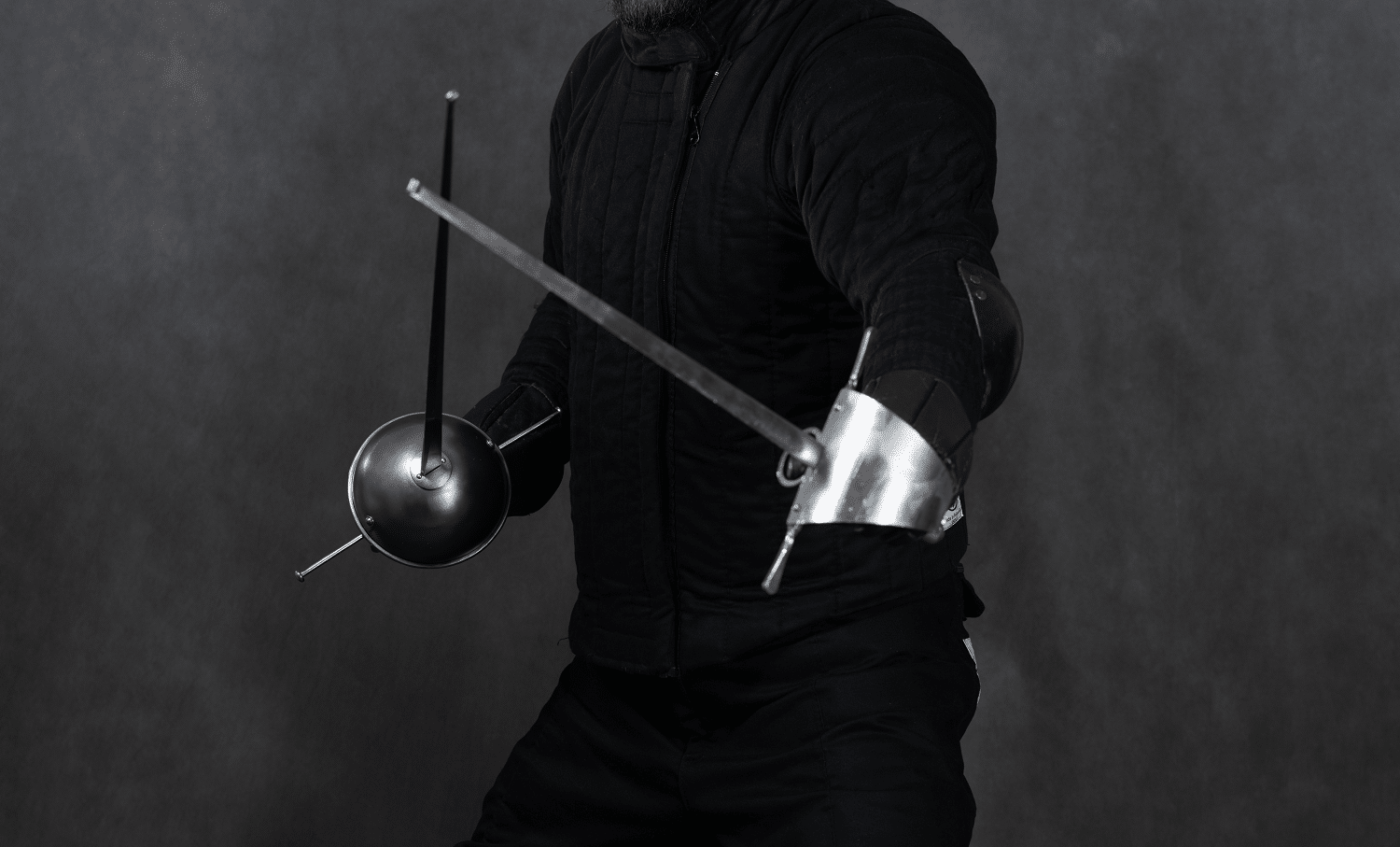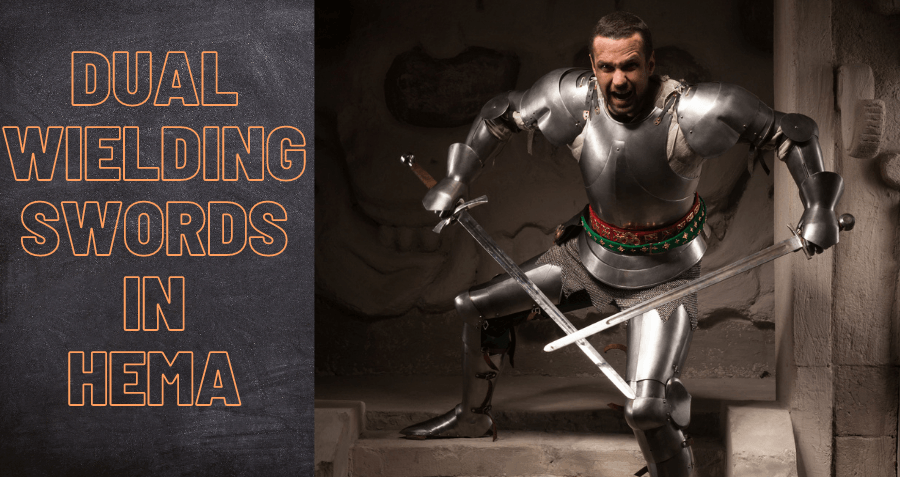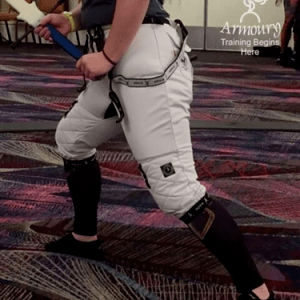Table of Contents
hide
Is HEMA Safe?
Yes generally speaking HEMA is safe. Historical sword fencing is a sport rooted in a martial tradition intended for life and death sword battles, but this does not mean historical fencing classes are strictly dangerous. HEMA schools and clubs utilize specialty equipment designed to make the practice of historically accurate swordsmanship far less dangerous than it would otherwise be, allowing for athletes to engage in high intensity sparring matches just as heated and cool looking as you would see in movies and video games — but without anyone getting killed or maimed!
Yet, fencing with even specialty weapons like federschwert (feders) designed for sport usage still requires all participants in the classes and tournaments to be mindful of individual safety, and this is regardless of the age and experience levels of the students.
If you follow the laid out guidelines and instructions we provide in this article, your HEMA sword fighting classes and events should be fairly safe and exciting games that run without anyone experiencing a major injury. Most importantly, they need to adhere to safety tips as follows.
Wear the Requisite Protective Equipment for Historical Fencing
You need to wear the ideal attire when fencing to uphold your safety at all times. Therefore, equipping properly safety rated masks, hand protection, long pants, chest protector, and fencing jackets is necessary. Without the correct apparel you should not practice any kind of fencing sparring at all whether it is drilled or freestyle sparring. It’s no secret that you will get injured if you don’t have proper equipment for swordfighting. Within Historical European martial arts (HEMA) fencing terminology, equipment is usually rated as either 350N , 800N and 1600N in material. This is the puncture resistance rating of fencing equipment. 350N is the bare minimum safety rating for constructing fencing mask bibs, as well as fencing jackets and pants. 800N is generally considered a good standard for high intensity freeplay sword fighting and is becoming standard for competition grade protective equipment used by the HEMA community. At the very least one must always wear a fencing mask and neck protection, such as a gorget. You should also have hand protection if you engage in any free-sparring, as even blunted blades can cut your hand open and will break the tiny bones of your fingers and thumb. If you’d like a detailed guide on beginner protective equipment please click here to read our article with a list of our recommendations.
Weapons Should Face Downwards When Not Fencing
It is a strict rule that you always point the tip of your historical fencing weapon downwards when you are not fencing, whether it is a longsword, rapier, sabre, smallsword, dagger or even a polearm. The weapon should not face with its tip upwards since it could potentially harm someone who walks by or even goes to pick it up. Furthermore even if your weapon has a rolled tip you should put a rubber blunt on it, as this will further prevent serious injuries such as your blade potentially piercing someone’s eye. Rolled tips can often cause cuts on naked flesh as well, so if you do drilling without fencing jackets it is better to use blunted tips if you are making light contact to people’s shirts and arms. Historical fencers show respect and consideration to their training partners when they consider their safety more important than things such as whether placing a blunt on their tip will impact their own performance by ruining the aerodynamics of their sword swings. Having a culture where the safety of participants is more important than individual performance will lead to a better school culture that retains students longer and gets positive word of mouth referrals.
Never Point Your Sword at Unmasked People
You should never ever point your weapon at a person who is unmasked since it is very dangerous. Even if you believe you have excellent tip control, it just takes one tiny mistake of someone turning their head or you having a brain fart for you to potentially blind them for life. While some veterans of the community may scoff at this because they feel very confident in their tip control, this very event has happened with an experienced instructor before and serves as a cautionary tale. The tragedy could have been avoided if a policy of always wearing a mask when engaging in any kind of drilling or demonstration was strictly enforced. Additionally, if your opponent is not ready to engage in a match with you then you should never play around with your sword, until he or she has put on their fencing mask. A fencing match should never begin until all participants has a mask on.
Inform your Opponent if their Gear is not Safe
Even if you are in a competition setting you should never let your desire to win outweigh the importance of safety. Part of the chivalrous knightly spirit we strive to create in the Historical European martial arts community is to look out for the safety of our opponents and training partners, too. Please pay close attention to the attire of your partners and opponents. If you notice that a glove is not worn correctly, or the jacket is partly unzipped, inform him or her about this. What’s more, if they have not tied their shoelaces, give them a heads up so that they can prevent themselves from tripping or slipping. Small details like this can have a huge impact in safety and prevent accidents that lead to injuries.
Inspect Your Weapon and Protective Gear Frequently
Your training swords and clothing are the tools that keep you safe when you are fencing and they require regular maintenance. For instance, a fencing mask whose straps are not ideally working can fall off during a match, exposing you to danger. Plus, if your weapon is not in excellent condition it could harm others or even yourself. Blades tend to develop small burs in the metal that can be sharp and will cut open training jackets, and definitely can pierce exposed skin during drilling. These burs can even develop during training sessions so you need to be mindful of hard blows your blade takes and inspect to see if burs develop if you are engaging in low equipment drilling with a training partner. We have an article written on how to conduct maintenance on your sword blade to remove burs. Please click here to read it.
Wear Clean and Proper Fencing Shoes for the Surface Area You Practice on
As a historical fencer you should always maintain cleanliness at all times to ward off any potential disease you or others might obtain. While walking in a city we can frequently walk over sidewalks and roads where people throw food, spit, and animals can urinate. All of these bacteria and disease are carried with your shoes and can be left as imprint on other places that you walk. This is why many people leave their shoes at the front of their house and don’t wear them on carpets. Likewise you shouldn’t wear your outside shoes on the space you engage in Historical European martial arts (HEMA) practice, either. Especially in our post-coronavirus epidemic world, you should wear clean shoes for fencing that don’t have any dirt, moisture, or particles that can make the fencing floor slippery (if you practice on a hard wooden floor), and don’t dirty the floor if you are going to engage in any grappling practices. This way you will be keeping yourself and other fencers safe from slipping on the hard surfaces. It is recommended that you have two pairs of shoes so that you can wear one on the training floor and the other when you are outside in your daily commute. Likewise when training you want to wear the appropriate footwear for the surface you are training on. Don’t wear thin flat soled sandals on slippery grass and don’t wear cleats on flat wooden flooring. Be sensible.
Don’t Lay Your HEMA Gear on the Training Floor Area
The fencing floor training area should be free from any equipment that can cause someone to stumble over and get harmed if they trip. If you are not using a piece of training equipment then it is prudent to store it so that you can have a clear working area. Clubs ideally should have a place for weapons to be stored when not in use that will not crowd walkways in the training center. You should also remove any bags so that everyone can have a safe area free of potential obstacles. As a side benefit to this your training place will also look neat and more aesthetically pleasing to potential new students, too. Cleanliness and tidiness are part of a professional martial arts school environment.
Stop Fencing if you Notice a Problem
At various times it becomes necessary for a training partner to signal that something is wrong. You might see your opponent waving with an unarmed hand or retreating in a strange fashion. In that case you should stop fencing and check to see what is wrong. Your training partner might have broken some part of their sword or gear, or suffered some other kind of injury that is not readily apparent to you. Communication is very important and you should listen to what people tell you, especially if it is related to safety concerns.
Inform the Instructor Immediately about Injuries
While small cuts and bruises can be commonplace, it is not a great idea to remain silent about any very painful injuries that you have incurred while engaging in swordplay. The issue could be serious, even if you don’t feel like it’s a major injury. Pride doesn’t always help and sometimes trying to endure an injury such as a sprained ankle or broken finger bone can make the problem worse. Hence you need to report any injuries immediately to your coach or instructor for help. Even if you think it could be a minor problem you should let an expert know so that he or she can intervene in the situation.
Stop Immediately if you Feel Discomfort or Pain
You might be tempted to continue fencing even though you are in excruciating pain. Don’t be the hero since the problem can have a ripple effect on your health. You could be suffering from muscle strain or twisted ankle that requires immediate medical attention. Therefore, you need to stop so that you can rest and get all the assistance that you need. Taking excellent care of yourself is equally important as winning the sport.
Non-Fencers Should Be Away from the Fencing Area
Besides the fencers themselves, spectators of tournament events such as family and friends have a role to play to ensure that the fencers are secure. Naturally the participants should ensure that they leave enough room between them and their cheering squads. Friends and family who have come to support their fencers shouldn’t be in close proximity to the fencing area, even in your club environment. It is possible for sometimes a blade to snap, and this broken blade can travel and potentially harm someone. While rare it can happen. In addition to this rare event, any fencers who are not training should not appear anywhere near the fencing floor. The rule is for their safety so that they can’t be in danger because they don’t have the right gear.
Report Overly Hostile Actions from Other Fencers
Historical fencing is not a violent sport that seeks to put someone in a hospital bed. Unsportsmanlike and overly hostile activity is not part of the knightly way but sometimes people fail to control their emotions and behave in poor form. If you notice that your competitor is acting strangely by wildly flailing their weapon around or using more force than is actually necessary to perform a technique, you should ask them to practice better control over their weapon. If they refuse then you should report this behavior to your coach. Likewise if you are very upset and angry about things you should not engage in any fencing activity as a way of working through your feelings. Historical fencing is not a way for you to blow off steam about your problems in life by beating on your training partners. You should only fence with an open heart desiring to learn and practice the knightly art of combat.
Don’t Carry Food and Beverages to the Fencing Zone
The fencing training area is not a place to enjoy your food and drinks since it’s designated for training. The odds are high that you will spill your soda or water on the floor, making it slippery and sticky. Plus, you will sometimes leave food crumbs that silly as it may sound, can actually cause someone to fall and fracture their ankle. Thus, it is only wise to keep all meals out of the zone so that everyone can be safe and sound.
**** We hope these training tips are helpful and will lead to safety in your training. If you’d like to learn more information about historical fencing practices please check out our Learn HEMA page for a guide to learning about the historical weapon that interests you. You can also find more guides we’ve written about other topics at our Helpful Guides page. You can also join the conversation at our forums or our Facebook Group community.
[/vc_column_text][/vc_column][/vc_row]

















